Today I’m going to take you on a journey through space and time to visit one of the most iconic jewels to have graced the neck of planetary royalty.
This piece, which has become iconic within the Sci-fi community, was not commissioned specifically for the film it appeared within but was acquired within the progressive studio of one of the emerging new wave of jewellery designers from earth’s mid-twentieth century. And was selected for its ‘otherworldly’ appearance due to the experimental use of materials and techniques by the designer, who was influenced by a wide range of subjects from the natural environment to artistic movements of the day, as well as of course, space itself.
So where does our story begin, well…
A long time ago, in a galaxy far, far away; well actually on a sound stage at Elstree studios near London, and maybe not that long ago for some of us. A Princess wore a necklace, oh and a bracelet but everyone forgets about that; and at least the hairstyling had got better by this scene. A necklace that though not forged from chalcedony or featuring Kyber Crystals from Ilum, had a name like all iconic totems, that of Planetoid Valley’s.
A necklace that became a star in its own right, far outshining the medals this Princess bestowed on the rebel fighters she had fought alongside, and had absolutely nothing to do with the lack of dialogue in the scene, well apart from Chewie’s triumphant interjection at the end obviously, that all eyes ended up being fixed upon her neck.
This now iconic necklace, one of a few Crown Jewels of Alderaan that survived the destruction of the planet by the Galactic Empire, with its ethereal beauty was a very Earthly design and no mere prop, or ‘costume jewellery’. It was bought from the London store of Lapponia, a Finnish jewellery house, whose head of design Björn Weckström had created revolutionary designs since the 1950’s, inspired by the natural environment of the Nordic landscape, and unlike anything that anyone had seen before.
The capturing of the natural environment within decorative arts, crafts and design wasn’t new by the time our Princess appears in the multiplexes of Earth in the mid-1970s. It had, in fact, emerged as a significant subject of inspiration in the middle of Earths twentieth century, and most notably within the decorative arts of the Nordic tribes of Earth. However, I’m sure if Hoth did have an indigenous population rather than just the slightly menacing yeti-like wampa’s, they too would have been inspired by their environment creatively.

Now the tribes of the Nordic states you could say were truly futuristic, that they were light years before their time, pushing the boundaries of design in creating works of decorative art and craft which were characterised by simplicity and functionality, and inspired by the nature, landscape, and climate of the North. Often referencing unique forms and textures found within geology, casting directly or using moulds that incorporated stone, wood and plants to achieve this. Whilst also looking to capture the more ephemeral natural phenomenon, such as the quality of light, or how ice is formed, and the way snow settles expressing this through glass, plastics and the finishes they applied to the surface of the metal. Within jewellery design, they positioned themselves away from influences in the rest of Earth’s Europe, far from the ornate jewellery design that was prevalent elsewhere, towards simpler forms which celebrated the beauty of the materials they used.
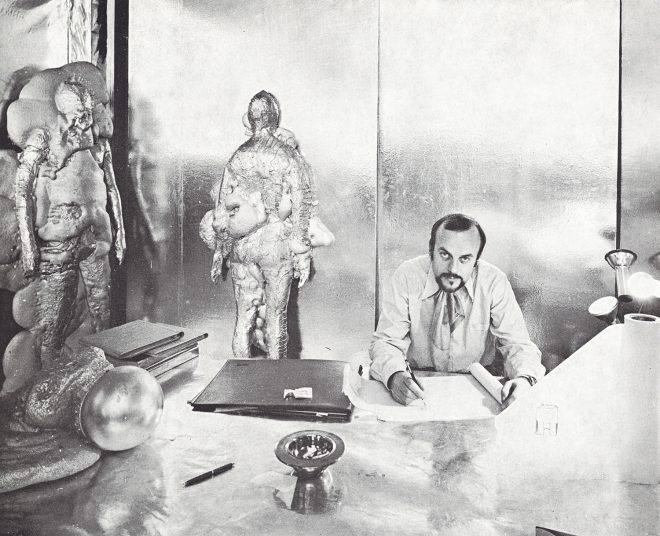
One designer who challenged the conventional norms of jewellery design to create truly futuristic pieces was the Finnish artist Björn Weckström . Whose studio, I have to say from this image taken in the 1960s, wouldn’t look out of place in a sci-fi film. Weckström is now internationally recognised for his artistic jewels, though in the late 1950’s he was at first seen as too radical for the Finnish market, placing his pieces within the same field of importance as his fine art and sculpture, which prompted one contemporary commentator of the day to say that he should come back in 100 years when society would be ready for such designs.
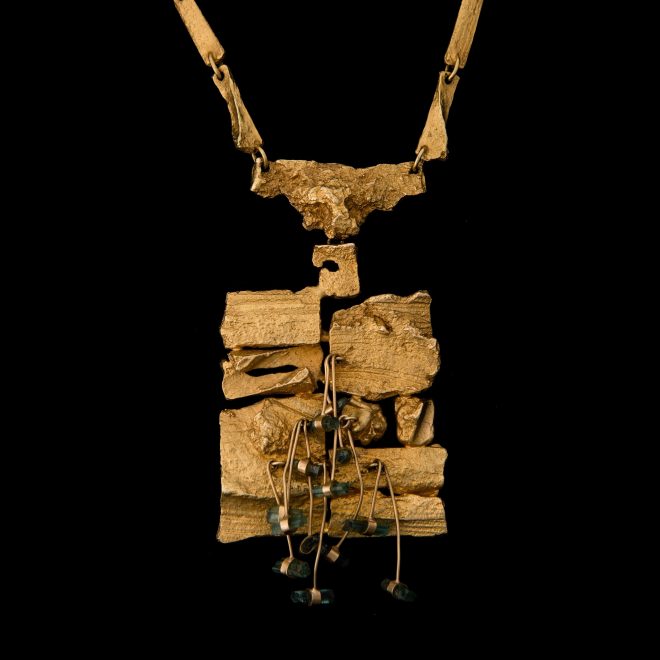
Photo © Björn Weckström/Kalevala Koru Oy
However, fellow goldsmith Pekka Anttila saw the significance of Weckström’s revolutionary designs and asked him to join his newly established company Lapponia. Here Björn Weckström created a range of pieces that drew inspiration from the shape and matte surface of gold nuggets found in Finnish Lapland, hence the name of the company. He was also one of the first designers to combine new materials such as acrylic with traditional precious metals. His highly sculptural designs came to international attention in 1965 after being awarded the Grand Prix for the above design ‘Flowering Wall’ at the International Jewelry Contest in Rio de Janeiro.

But back to our Princess’s necklace. Planetoid Valleys was conceived by Weckström in the late 1960’s and ironically because of its association with the film, many do not realise that the form and shape was conceived following Weckström’s study into how snow falls in drifts and not the sand dunes of Tatween.
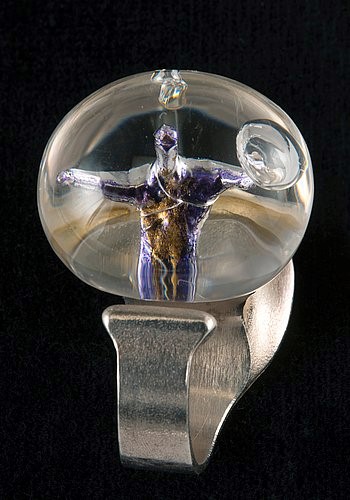
Photo © Björn Weckström/Kalevala Koru Oy
It was during earth’s late 1960’s and the success of the Apollo 11 mission to land a man on the moon, that saw a number of jewellery designers creating pieces that directly responded to the exploration of space as well as the advancements in technology that this decade had brought. Wecktröm was part of this movement, with his Space Collection, which Planetoid Valleys sits within, exploring the creation of worlds within silver, gold and acrylics.
These were radical pieces, highly sculptural, often incorporating large acrylic elements that stood proudly away from the body. No dainty set was to be seen in the showrooms of Lapponia, these were pieces for the fashion and art-conscious new generation of women who bought for themselves, and wanted to stand out. And this is the essential thing, these were available on the open market, you could acquire them, and still can.
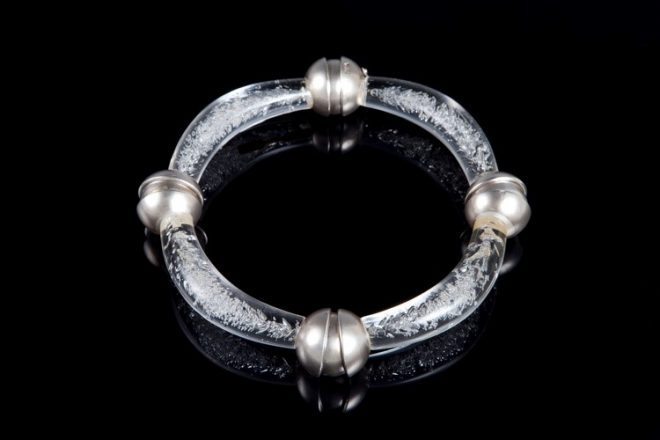
As we can see from these examples, Wecktröm’s designs are pieces of art in their own right. They also have a timeless quality to them, and you could conceivably think that they were created today. So we can see why Lucas Films were so drawn to his designs, and how they reflected a futuristic or alternative civilisation that was the ethos of Star Wars.
Just as a side note, originally Wecktröm had been approached by Lucas Films in the spring of 1976 to design a bespoke piece for an undisclosed science fiction film. However, due to a film scheduling mishap, they needed a quick alternative, so Björn suggested they went shopping at Lapponia’s store in London, where they had an outlet in the mid-1970s. This was where they acquired Planetoid Valley, and also Wecktröm’s Darina bracelet let us not forget. Slightly tactless though, Lucas Films forgot to tell Björn or Lapponia which film the pieces were to appear within. So, it wasn’t until Björn’s friend went to see ‘New Hope’ at a cinema in Helsinki that he found out, and was how the legend began.
But our heroine’s story does not stop there, after all she was a Princess, even if of an aforementioned blown up planet. She still did have some ancestral pieces stashed away in the vaults of the Bank of Aargau, even if she did have to sell some of them to pay for a new fleet of X-wing fighters.
Luckily for us mere Earthlings, the women who played her, the late and great Carrie Fisher, knew the importance of heirlooms within this narrative and was instrumental in the placement of jewels within the most recent episodes.
Though the pieces that adorn her as General Leia Organa in ‘The Last Jedi’, a rather striking arts and crafts style ring; an Etruscan style bracelet; and those amazing earrings; have not been credited to a known designer, as yet, this doesn’t mean they were just merely created by the props department. As we have already seen with her ceremonial necklace, Lucas Films are happy to source from contemporary practitioners of the day, or in fact, more accurately, designs that had been conceived in a previous decade or generation to intone the aesthetic they desired.
Because, you know, the more I look at those amazing earrings, the more I keep thinking to myself, I have seen them somewhere else before….
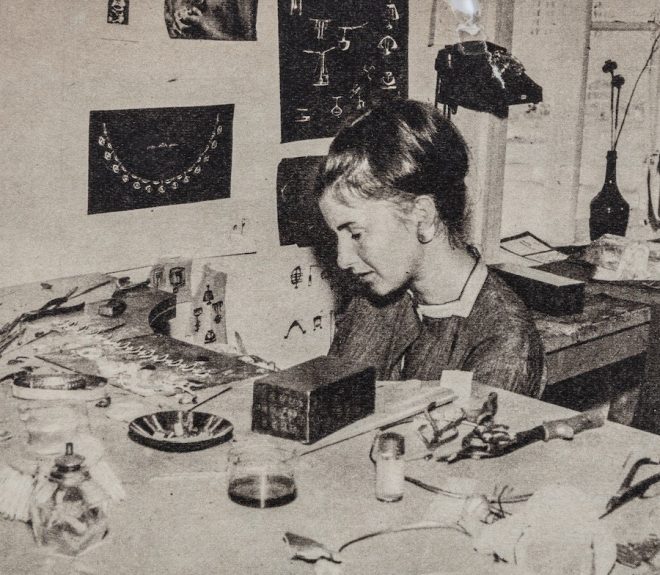
On the ears of one of Norway’s most celebrated modernist and contemporary jewellers. Highly respected for her work that references Norse ethnographic and archaeological decorative arts, Tone Vigeland developed her earrings for PLUS Applied Arts Centre in Fredrikstad, when she joined the company in 1958 and was put into production by Norway Silver Designs in the same year.
The first range of pieces she created for PLUS, many of which she had developed whilst still a student, followed the modernist aesthetic that combined good form, clean surfaces and sensitivity towards materials. She was part of an emerging generation in the 1950s that created pieces that came to epitomise Norwegian Modernist Jewellery design, that played on their Norse heritage incorporating stylised Viking motifs such as axe heads, and abstracted geometric designs, often incorporating enamelled decoration, which showcased their strengths within manufacture.
There was a lot of references to mythological and ancient religions during this period throughout Europe and the United States, think wide torques with large symbol pendants. Kind of like Jenny Agatar’s Logan Runs torque and ankh. Possibly here too is another example where the costume department got their idea for her look.

Anyway, you can definitely see the influence of traditional Norse jewellery within the forms of the earrings. Similar pieces can be found in Viking hoards across Northern Europe, and was a recurring design trope within the Modernist movement to reference or show influence, through the abstraction of designs from both ethnographical and archaeological collections of ancient civilisations. So, it would seem logical, opps that a different franchise; the Force would dictate, that to establish an aesthetic for the ancestral heirlooms of the House of Organa, one must journey to find those designers or pieces that evoke a sense history and yet at the same time seem futuristic.
I have to say there is a strikingly similarity to the pieces worn by the esteemed General Organa and Vieglands creations, it may be just coincidence as they are not credited, but it seems highly likely that these, if not her own, were inspired by Viegland’s Sling earrings, or like herself, the archaeological collections of a once great warrior nation.
